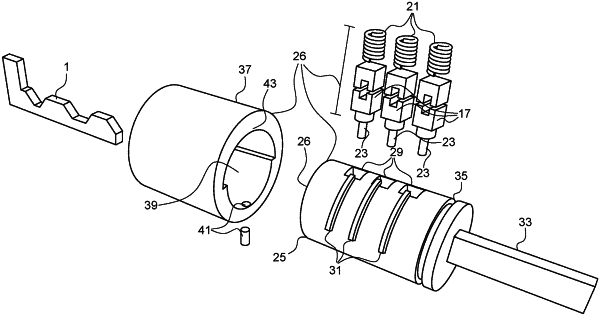| CPC E05B 27/02 (2013.01) [E05B 27/0007 (2013.01); E05B 27/006 (2013.01); E05B 27/086 (2013.01)] | 20 Claims |

|
1. An apparatus including:
a key; and
a lock including:
a fixed frame having a space;
a movable frame having a range of motion within the said space and at least one opening, shaped such that said key may be applied to each said opening;
at least one tooth adjacent each said opening; and
a mechanism that regulates the motion by determining an orientation and/or position of each said tooth, the mechanism comprising, for each said tooth:
an avenue in the fixed frame;
for each said avenue in the fixed frame:
an avenue in the movable frame,
said avenues being disoriented except when aligned to form a combined avenue,
the tooth in the avenue in the fixed frame and extendible into the combined avenue during a locked condition,
a pushing mechanism that
disposes the tooth to a position at an end of the combined avenue adjacent to the opening that is adjacent to the tooth and that disposes the tooth located in the avenue of the fixed frame to a position at an end of the avenue when the avenue and the other avenue are not aligned,
an actuator having an other range of motion which corresponds to the range of motion of the moveable frame, and
a mechanical resistor,
wherein
the key is configured to act through the opening to the combined avenue to displace the tooth from the combined avenue into the avenue of the fixed frame, or to shift the orientation of the tooth within the avenue of the fixed frame, or both, and the motion of the moveable frame causes avenue within the movable frame and the avenue in the fixed frame to no longer form the combined avenue thereby blocking the tooth from access via the avenue of the movable frame and the openings for the key and, after the access has been blocked, the tooth is compared to the mechanical resistor to allow the moveable frame to carry out the motion until the actuator progresses fully through the actuator's range of motion, and
otherwise the tooth is separated from the avenue in the movable frame and from the openings for the key, and only then interfaces with the mechanical resistor to arrest the motion of the moveable frame and prevent from opening the lock, such that the tooth does not seize the lock.
|